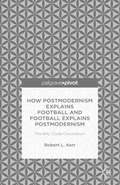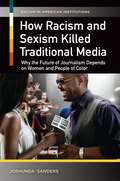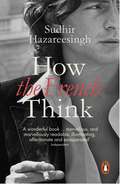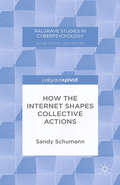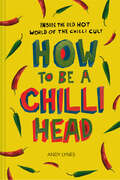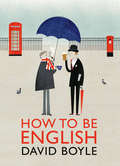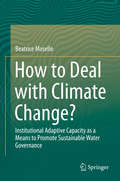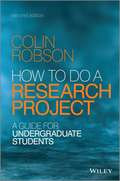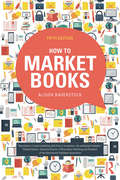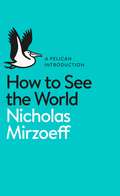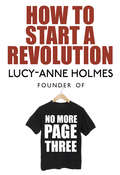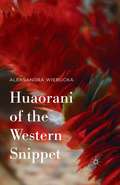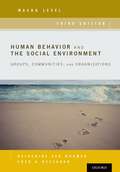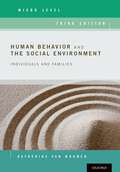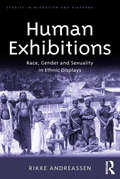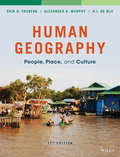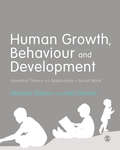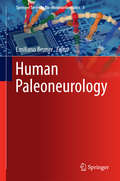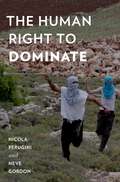- Table View
- List View
How Postmodernism Explains Football and Football Explains Postmodernism: The Billy Clyde Conundrum
by Robert KerrAmerican football and postmodernist theory are both objects of popular and scholarly interest that reveal remarkable sociological insights. Analysis of media-driven commercial football documents how narratives of sportsmanship/brutality, heroism/antiheroism, athleticism/self-indulgence, honor/chicanery, and chivalry/sexism compete and thrive.
How Racism and Sexism Killed Traditional Media: Why the Future of Journalism Depends on Women and People of Color (Racism in American Institutions)
by Joshunda SandersAn evaluative examination that challenges the media to rise above the systematic racism and sexism that persists across all channels, despite efforts to integrate.The Internet and social networks have opened up new avenues of communication for women and people of color, but the mainstream news is still not adequately including minority communities in the conversation. Part of the Racism in America series, How Racism and Sexism Killed the Traditional Media: Why the Future of Journalism Depends on Women and People of Color reveals the lack of diversity that persists in the communication industry. Uncovering and analyzing the racial bias in the media and in many newsrooms, this book reveals the lesser-known side of the media—newsrooms and outlets that are often fraught with underlying racist and sexist tension.Written by a veteran journalist of color, this title brings an insider's perspective combined with interviews from industry experts. The book analyzes the traditional media's efforts to integrate both women and people of color into legacy newsrooms, highlighting their defeats and minor successes. The author examines the future of women and people of color in the mainstream media.
How Racism and Sexism Killed Traditional Media: Why the Future of Journalism Depends on Women and People of Color (Racism in American Institutions)
by Joshunda SandersAn evaluative examination that challenges the media to rise above the systematic racism and sexism that persists across all channels, despite efforts to integrate.The Internet and social networks have opened up new avenues of communication for women and people of color, but the mainstream news is still not adequately including minority communities in the conversation. Part of the Racism in America series, How Racism and Sexism Killed the Traditional Media: Why the Future of Journalism Depends on Women and People of Color reveals the lack of diversity that persists in the communication industry. Uncovering and analyzing the racial bias in the media and in many newsrooms, this book reveals the lesser-known side of the media—newsrooms and outlets that are often fraught with underlying racist and sexist tension.Written by a veteran journalist of color, this title brings an insider's perspective combined with interviews from industry experts. The book analyzes the traditional media's efforts to integrate both women and people of color into legacy newsrooms, highlighting their defeats and minor successes. The author examines the future of women and people of color in the mainstream media.
How the French Think: An Affectionate Portrait of an Intellectual People
by Sudhir HazareesinghSudhir Hazareesingh's How the French Think is a warm yet incisive exploration of the French intellectual tradition, and its exceptional place in a nation's identity and lifestyleWhy are the French an exceptional nation? Why do they think they are so exceptional? An important reason is that in France intellectual activity is regarded not just as the preserve of the thinking elite but for almost everyone. French thought can sometimes be austere and often opaque, yet it is undeniably bold and innovative, and driven by a relentless quest for the regeneration of humanity. Sudhir Hazareesingh traces its tumultuous history in an enormously enjoyable and highly original manner, showing how the French ways of thought and life connect. This will be one of the most revealing books written about them - or any other European country - for years.Sudhir Hazareesingh was born in Mauritius. He is a Fellow of the British Academy and has been a Fellow and Tutor in Politics at Balliol College, Oxford, since 1990. Among his books are The Legend of Napoleon (Granta, 2004) and Le MytheGaullien (Gallimard, 2010). He won the Prix du Memorial d'Ajaccio and the Prix de la Fondation Napoleon for the first of these, and a Prix d'Histoire du Senat for the second.
How the Internet Shapes Collective Actions (Palgrave Studies in Cyberpsychology)
by S. SchumannAfter a Facebook rebellion in Egypt and Twitter protests in Turkey, the internet has been proclaimed as a globe-shifting, revolutionizing force that can incite complex social phenomena such as collective actions. This book critically assesses this claim and highlights how internet use can shape mobilizing processes to foster collective actions.
How to Be A Chilli Head
by Andy LynesWelcome to the world of the chilli cult. All over the globe, people are getting together to grow chilli, taste chilli and make sauce hot enough to blow their heads off. Competition among chilli -growers is fierce, and tall tales of dastardly deeds abound. This sizzling-hot book is your essential guide to the chilli world, with inside information on where to find the tastiest varieties, where to eat the best chilli -packed street food, and the race to produce the hottest chilli ever known. Find out the secrets of chilli science – why a slug of water won't help when your mouth's on fire, what effect eating a super-hot chilli has on your body, and how do you measure how hot a chilli is? If you want to grow your own chilli, this book contains a wealth of foolproof cultivation tips, and, of course, there's a delicious selection of chilli recipes to make with your first harvest. Packed with features, facts and fun,How to Be a ChilliHeadis the perfect gift for the chilli obsessive in your life. Word count: 20,000
How to Be English
by David BoyleEnglish culture is confused, muddled and often borrowed. The purpose of this book is to give the reader a complete grounding in the idiosyncrasies of the English and to pin down the absurdities and warmth of Englishness at its best.Featured in this book are such established English cultural behemoths as the Beatles, Big Ben and the Last Night of the Proms alongside less celebrated quirks such as meat pies and the working man’s haven, the allotment. Here we celebrate the bell-ringers and Morris dancers, bowler hats (‘the symbol of respectable Englishness’) and cardigans (‘symbol of staid middle-class solidarity’). We examine the brutality of Punch and Judy and our historic love of fairies, once so much a part of the English psyche that they were described as ‘the British religion’.At once fond and irreverent, laudatory and curious, How to Be English might just teach us how to be English once again.
How to Deal with Climate Change?: Institutional Adaptive Capacity as a Means to Promote Sustainable Water Governance
by Beatrice MoselloAs the evidence for human-induced climate change becomes more obvious, so too does the realisation that it will harshly impact on the natural environment as well as on socio-economic systems. Addressing the unpredictability of multiple sources of global change makes the capacity of governance systems to deal with uncertainty and surprise essential. However, how all these complex processes act in concert and under which conditions they lead to the sustainable governance of environmental resources are questions that have remained relatively unanswered. This book aims at addressing this fundamental gap, using as case examples the basins of the Po River in Northern Italy and the Syr Darya River in Kyrgyzstan. The opening chapter addresses the challenges of governing water in times of climate and other changes. Chapter Two reviews water governance through history and science. The third chapter outlines a conceptual framework for studying institutional adaptive capacity. The next two chapters offer detailed case studies of the Po and Syr Darya rivers, followed by a chapter-length analysis and comparison of adaptive water resources management in the two regions. The discussion includes a description of resistant, reactive and proactive institutions and puts forward ideas on how water governance regimes can transition from resistant to proactive. The final chapter takes a high-level view of lessons learned and how to transform these into policy recommendations and offers a perspective on embracing uncertainty and meeting future challenges.
How To Do A Research Project 2E - A Guide For Undergraduate Students
by Colin RobsonWritten specifically to address the needs and concerns of the undergraduate, this tightly focused second edition guides students through the process of conducting and completing a research project. Friendly and accessible, this fully-updated second edition includes a number of accompanying student support materials to aid students further. Closely integrated sets of end-of-chapter tasks covering all aspects of research projects from design to completion, as well as suggested further reading, enhance each chapter. A wide range of additional helpful materials relevant to particular subject areas is also available on the accompanying website at www. wiley. com/college/robson. This textbook is an invaluable resource for students in a wide range of disciplines and fields of study, particularly those planning to use social research methods or to carry out a library-based study, for their undergraduate research project.
How to Do Things with Pornography
by Nancy BauerIn Nancy Bauer’s view, most feminist philosophers are content to work within theoretical frameworks that are false to human beings’ everyday experiences. Here she models a new way to write about pornography, women’s self-objectification, hook-up culture, and other contemporary phenomena, and in doing so she raises basic questions about philosophy.
How to Do Things with Pornography
by Nancy BauerIn Nancy Bauer’s view, most feminist philosophers are content to work within theoretical frameworks that are false to human beings’ everyday experiences. Here she models a new way to write about pornography, women’s self-objectification, hook-up culture, and other contemporary phenomena, and in doing so she raises basic questions about philosophy.
How to Market Books
by Alison Baverstock'Baverstock is to book marketing what Gray is to anatomy; the undisputed champion.' Richard Charkin, Executive Director of Bloomsbury Publishing and President Elect of the International Publishers Association Over four editions, Alison Baverstock’s How to Market Books has established itself as the industry standard text on marketing for the publishing industry, and the go-to reference guide for professionals and students alike. With the publishing world changing like never before, and the marketing and selling of content venturing into uncharted technological territory, this much needed new edition seeks to highlight the role of the marketer in this rapidly changing landscape. The new edition is thoroughly updated and offers a radical reworking and reorganisation of the previous edition, suffusing the book with references to online/digital marketing. The book maintains the accessible and supportive style of previous editions but also now offers: a number of new case studies detailed coverage of individual market segments checklists and summaries of key points several new chapters a foreword by Michael J Baker, Professor Emeritus of Marketing, Strathclyde University.
How to Market Books
by Alison Baverstock'Baverstock is to book marketing what Gray is to anatomy; the undisputed champion.' Richard Charkin, Executive Director of Bloomsbury Publishing and President Elect of the International Publishers Association Over four editions, Alison Baverstock’s How to Market Books has established itself as the industry standard text on marketing for the publishing industry, and the go-to reference guide for professionals and students alike. With the publishing world changing like never before, and the marketing and selling of content venturing into uncharted technological territory, this much needed new edition seeks to highlight the role of the marketer in this rapidly changing landscape. The new edition is thoroughly updated and offers a radical reworking and reorganisation of the previous edition, suffusing the book with references to online/digital marketing. The book maintains the accessible and supportive style of previous editions but also now offers: a number of new case studies detailed coverage of individual market segments checklists and summaries of key points several new chapters a foreword by Michael J Baker, Professor Emeritus of Marketing, Strathclyde University.
How to See the World
by Nicholas MirzoeffIn recent decades, we have witnessed an explosion in the number of visual images we encounter, as our lives have become increasingly saturated with screens. From Google Images to Instagram, video games to installation art, this transformation is confusing, liberating and worrying all at once, since observing the new visuality of culture is not the same as understanding it. Nicholas Mirzoeff is a leading figure in the field of visual culture, which aims to make sense of this extraordinary explosion of visual experiences. As Mirzoeff reminds us, this is not the first visual revolution; the 19th century saw the invention of film, photography and x-rays, and the development of maps, microscopes and telescopes made the 17th century an era of visual discovery. But the sheer quantity of images produced on the internet today has no parallels. In the first book to define visual culture for the general reader, Mirzoeff draws on art history, theory and everyday experience to provide an engaging and accessible overview of how visual materials shape and define our lives.
How to Start a Revolution
by Lucy-Anne HolmesA bite-sized guide to making change happen and the story behind the No More Page 3 campaign, written by its founder. Change doesn’t just happen. It starts with the idea that something could be different, could be better. It starts with a person who is brave enough to stand up and say, ‘Stop.’ This is what Lucy-Anne Holmes did when she wrote a letter to the editor of The Sun asking him to stop printing pictures of topless women on Page 3 of the paper. This was something that had been happening for forty five years but which - she suddenly realised - she found outdated and inappropriate and, after thinking about it, not unrelated to a lot of the bad things that happen to women. Launching a digital campaign, starting an online petition and recruiting a team of like-minded people, Lucy-Anne started a revolution. Hundreds of thousands of people signed the petition, wore the campaign t-shirt and dared to say #NoMorePage3. Lucy-Anne had never campaigned on anything before. She wasn't particularly political. She'd never been confrontational. But she found that you only need one thing to start a campaign - and it isn't cash, experience or even a thick skin. It's passion.If you have a desire to change something, read what Lucy-Anne has to say. She’s been there, done that, worn the t-shirt and come out the other side having made a difference in the world.
Huaorani of the Western Snippet
by Aleksandra Wierucka BuchbinderHuaorani of the Western Snippet documents changes that the Huaorani culture of eastern Ecuador underwent over a period of fifty years. Part I focuses on the geographical, historical, sociological and economical background of the Ecuadorian Amazon as well as the problems that indigenous groups of this region face. Part II describes different aspects of Huaorani culture, and its consecutive subsections present research completed by anthropologists in different decades of twentieth century, and the data is reviewed and supplemented with data gathered during my research (2007-2013). Part III explores the life of a Huao man, Miñe, who serves as a local shaman. His different social roles are discussed in consecutive subsections in order to understand what shaped him as a person of the Huaorani group.
Human Behavior and the Social Environment, Macro Level: Groups, Communities, and Organizations
by Fred Besthorn Katherine Van WormerA timely revision in this global age, Human Behavior and the Social Environment, Macro Level develops a sophisticated and original view of the cultural, global, spiritual, and natural worlds that people inhabit, and explores the impact of these worlds on human behavior. An ecosystems/sustainability framework emerges as a key characteristic of contemporary practice. What is sustainable social work? What are the characteristics of a sustainable community? How is the present exploitation of environmental resources unsustainable for future generations? In accordance with the 2015 Council on Social Work Education (CSWE) standards, attention is paid to environmental justice as well as diversity and difference.
Human Behavior and the Social Environment, Micro Level: Individuals and Families
by Katherine Van WormerHuman Behavior and the Social Environment, Micro Level draws on a resilience model to explore the dynamics of human behavior across the life span. Biological, psychological, and spiritual dimensions are covered. Illustrations and vignettes from social work, psychology, literature, philosophy, and current events highlight the turning points in our lives. Critical thinking questions are provided. The result is an essential book that bridges theory and practice in accordance with the 2015 Council on Social Work Education (CSWE) standards.
Human Exhibitions: Race, Gender and Sexuality in Ethnic Displays (Studies in Migration and Diaspora)
by Rikke AndreassenFrom the 1870s to the second decade of the twentieth century, more than fifty exhibitions of so-called exotic people took place in Denmark. Here large numbers of people of Asian and African origin were exhibited for the entertainment and ’education’ of a mass audience. Several of these exhibitions took place in Copenhagen Zoo, where different ’villages’, constructed in the middle of the zoo, hosted men, women and children, who sometimes stayed for months, performing their ’daily lives’ for thousands of curious Danes. This book draws on unique archival material newly discovered in Copenhagen, including photographs, documentary evidence and newspaper articles, to offer new insights and perspectives on the exhibitions both in Copenhagen and in other European cities. Employing post-colonial and feminist approaches to the material, the author sheds fresh light on the staging of exhibitions, the daily life of the exhibitees, the wider connections between shows across Europe and the thinking of the time on matters of race, science, gender and sexuality. A window onto contemporary racial understandings, Human Exhibitions presents interviews with the descendants of displayed people, connecting the attitudes and science of the past with both our (continued) modern fascination with ’the exotic’, and contemporary language and popular culture. As such, it will be of interest to scholars of sociology, anthropology and history working in the areas of gender and sexuality, race, whiteness and post-colonialism.
Human Exhibitions: Race, Gender and Sexuality in Ethnic Displays (Studies in Migration and Diaspora)
by Rikke AndreassenFrom the 1870s to the second decade of the twentieth century, more than fifty exhibitions of so-called exotic people took place in Denmark. Here large numbers of people of Asian and African origin were exhibited for the entertainment and ’education’ of a mass audience. Several of these exhibitions took place in Copenhagen Zoo, where different ’villages’, constructed in the middle of the zoo, hosted men, women and children, who sometimes stayed for months, performing their ’daily lives’ for thousands of curious Danes. This book draws on unique archival material newly discovered in Copenhagen, including photographs, documentary evidence and newspaper articles, to offer new insights and perspectives on the exhibitions both in Copenhagen and in other European cities. Employing post-colonial and feminist approaches to the material, the author sheds fresh light on the staging of exhibitions, the daily life of the exhibitees, the wider connections between shows across Europe and the thinking of the time on matters of race, science, gender and sexuality. A window onto contemporary racial understandings, Human Exhibitions presents interviews with the descendants of displayed people, connecting the attitudes and science of the past with both our (continued) modern fascination with ’the exotic’, and contemporary language and popular culture. As such, it will be of interest to scholars of sociology, anthropology and history working in the areas of gender and sexuality, race, whiteness and post-colonialism.
Human Geography: People, Place, and Culture
by Erin H. Fouberg Alexander B. Murphy Harm J. de BlijFouberg’s Human Geography, 11th Edition teaches students to appreciate the diversity of people, places, and cultures, and understand the role people play in shaping our world. The goals of this edition are to provide geographic context to global, regional, national and local issues and to teach students to think geographically and critically about these issues. Human Geography: People, Place, and Culture features beautifully designed maps, dozens of vibrant photographs taken by the author team, and author and guest field notes that help students see how geographers read cultural landscapes and use fieldwork to understand places. A newly designed demographic data table includes economic, political, and population data, all of which can be examined in ArcGIS Online.
Human Growth, Behaviour and Development: Essential Theory and Application in Social Work (1st edition) (PDF)
by Alastair Gibson Neil GibsonUnderstanding the way in which individuals develop before birth, as babies, children and adolescents through to young and older adulthood towards death is an important part of any social work role. Being able to skilfully apply this understanding in real life practice situations is even more important, as purposeful translations of human development are at the heart of effective professional practice. Introducing students to emotional, psychological and social developmental theories of human growth before exploring in detail how these theories can be incorporated into practice, this book will ensure students have all the tools they need to not only understand but critically appraise and apply psychosocial theories early on in training and whilst on placement. With the help of real world case studies, summaries and tips for further study, it will show students how life course theories inter-relate and how they can make appropriate, purposeful translations of theory into skilled, professional practice.
Human Growth, Behaviour and Development: Essential Theory and Application in Social Work (1st edition)
by Alastair Gibson Neil GibsonUnderstanding the way in which individuals develop before birth, as babies, children and adolescents through to young and older adulthood towards death is an important part of any social work role. Being able to skilfully apply this understanding in real life practice situations is even more important, as purposeful translations of human development are at the heart of effective professional practice. Introducing students to emotional, psychological and social developmental theories of human growth before exploring in detail how these theories can be incorporated into practice, this book will ensure students have all the tools they need to not only understand but critically appraise and apply psychosocial theories early on in training and whilst on placement. With the help of real world case studies, summaries and tips for further study, it will show students how life course theories inter-relate and how they can make appropriate, purposeful translations of theory into skilled, professional practice.
Human Paleoneurology (Springer Series in Bio-/Neuroinformatics #3)
by Emiliano BrunerThe book presents an integrative review of paleoneurology, the study of endocranial morphology in fossil species. The main focus is on showing how computed methods can be used to support advances in evolutionary neuroanatomy, paleoanthropology and archaeology and how they have contributed to creating a completely new perspective in cognitive neuroscience. Moreover, thanks to its multidisciplinary approach, the book addresses students and researchers approaching human paleoneurology from different angles and for different purposes, such as biologists, physicians, anthropologists, archaeologists and computer scientists. The individual chapters, written by international experts, represent authoritative reviews of the most important topics in the field. All the concepts are presented in an easy-to-understand style, making them accessible to university students, newcomers and also to anyone interested in understanding how methods like biomedical imaging, digital anatomy and computed and multivariate morphometrics can be used for analyzing ontogenetic and phylogenetic changes according to the principles of functional morphology, morphological integration and modularity.
The Human Right to Dominate (Oxford Studies in Culture and Politics)
by Nicola Perugini Neve GordonAt the turn of the millennium, a new phenomenon emerged: conservatives, who just decades before had rejected the expanding human rights culture, began to embrace human rights in order to advance their political goals. In this book, Nicola Perugini and Neve Gordon account for how human rights--generally conceived as a counter-hegemonic instrument for righting historical injustices--are being deployed to further subjugate the weak and legitimize domination. Using Israel/Palestine as its main case study, The Human Right to Dominate describes the establishment of settler NGOs that appropriate human rights to dispossess indigenous Palestinians and military think-tanks that rationalize lethal violence by invoking human rights. The book underscores the increasing convergences between human rights NGOs, security agencies, settler organizations, and extreme right nationalists, showing how political actors of different stripes champion the dissemination of human rights and mirror each other's political strategies. Indeed, Perugini and Gordon demonstrate the multifaceted role that this discourse is currently playing in the international arena: on the one hand, human rights have become the lingua franca of global moral speak, while on the other, they have become reconstrued as a tool for enhancing domination.
